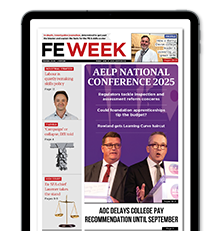John Hyde raises grave doubts about apprenticeship reform plans.
I once owned a small part of a racehorse, which has long since gone to that great pet food factory in the sky.
However this introduced me to the world of bookmakers and betting odds, no better demonstrated that Leicester City’s 5,000/1 winning [the football Premier League] bet.
I wonder what odds the bookmakers would give on the government achieving their 3m apprenticeship starts.
Before last weeks’ Department for Business, Innovation and Skills (BIS)/ Skills Funding Agency (SFA) announcements, I thought it could be achieved.
Now I doubt it achievable, unless they fudge it by stuffing thousands of government employees onto apprenticeships.
While there are trepidations about the Digital Apprenticeship Service software programmes being ready and fit for purpose, many other concerns of the government’s own making will frustrate achieving their target.
What a waste of taxpayers’ money and bureaucratic overkill
Apprenticeship growth has mostly come from small and medium size enterprises (SMEs).
Most SMEs, while funding their own apprentices’ wages, have made no financial contribution to the cost of the programmes.
Despite funding being discounted by up to 50 per cent for certain age groups and categories of apprentices, the majority of employers have made no cash contribution to their training provider.
This is well known in work-based learning circles, but continues to come as a surprise to ministers and Treasury officials.
It is going to come as a surprise to most SMEs that they will have to make a financial contribution to their training provider from April 2017.
Bizarrely, most employers will receive more cash back than they pay out from completion payments.
So we have this absurd scenario of cash going backwards and forward, closely monitored by the reduced SFA.
What a waste of taxpayers’ money and bureaucratic overkill.
Providers will encourage SMEs to bring apprenticeship plans forward, bringing a surge of starts before next April.
Thereafter, a sharp drop-off is likely unless the whacky paper-chase of invoices and cash payments both ways is eliminated.
SMEs are facing a tough time, with the increased minimum wage and mandatory pension contributions.
The second announcement concerned the SFA wanting to implement the new standards in all sectors immediately.
When Skills Minister Nick Boles was appointed, he promised the Trailblazer standards would be properly piloted and evaluated.
Yet without any new standard having been completed or any end-assessment tested, priced, available or even sat, the department is still hell bent on changing over, frequently rubbishing the existing frameworks with no empiric evidence to support its arguments.
Moving to the standards without completing a single pilot is like Ford going into full mass production of a new model without even completing a prototype or testing it.
Unless the new standard has a qualification, you don’t even need qualified trainers/assessors/tutors to deliver or assess. How does this improve quality?
Outside of BIS/SFA and a few vested interests, the whole sector is highly critical of the new standards and see them as a train crash waiting to happen.
There are many horror stories emerging from employers intending to abuse the levy, especially regarding paying young people the apprenticeship slave wage and sacking them after completing, especially in the retail sector. BHS ethical management comes to mind!
Now we know the IfA will have a total staff of just 40 to monitor the quality of apprenticeships.
With one million apprentices on programme by 2020, up to 800 standards/frameworks and 4,000 providers, who is kidding who quality will improve?
Around 710,000 apprentices are on-programme today, and this is set to expand by 2020.
If the government has its way, the end tests would mean in excess of 1m face-to-face interviews and practical skills tests in-year.
Assuming 230 working days per year, there would be over 4,000 practical tests and face-to-face interviews taking place every day across England.
Where is the workforce and structure to implement this?
Only within the current providers’ workforce and facilities, not with the awarding bodies or professional institutions who are coming forward to be assessment organisations.








Your thoughts